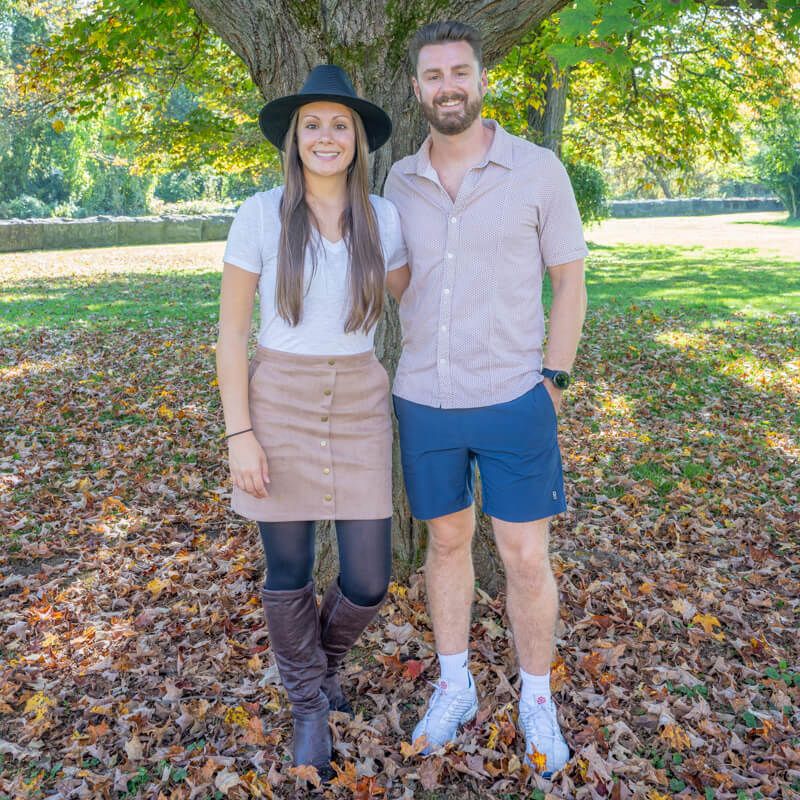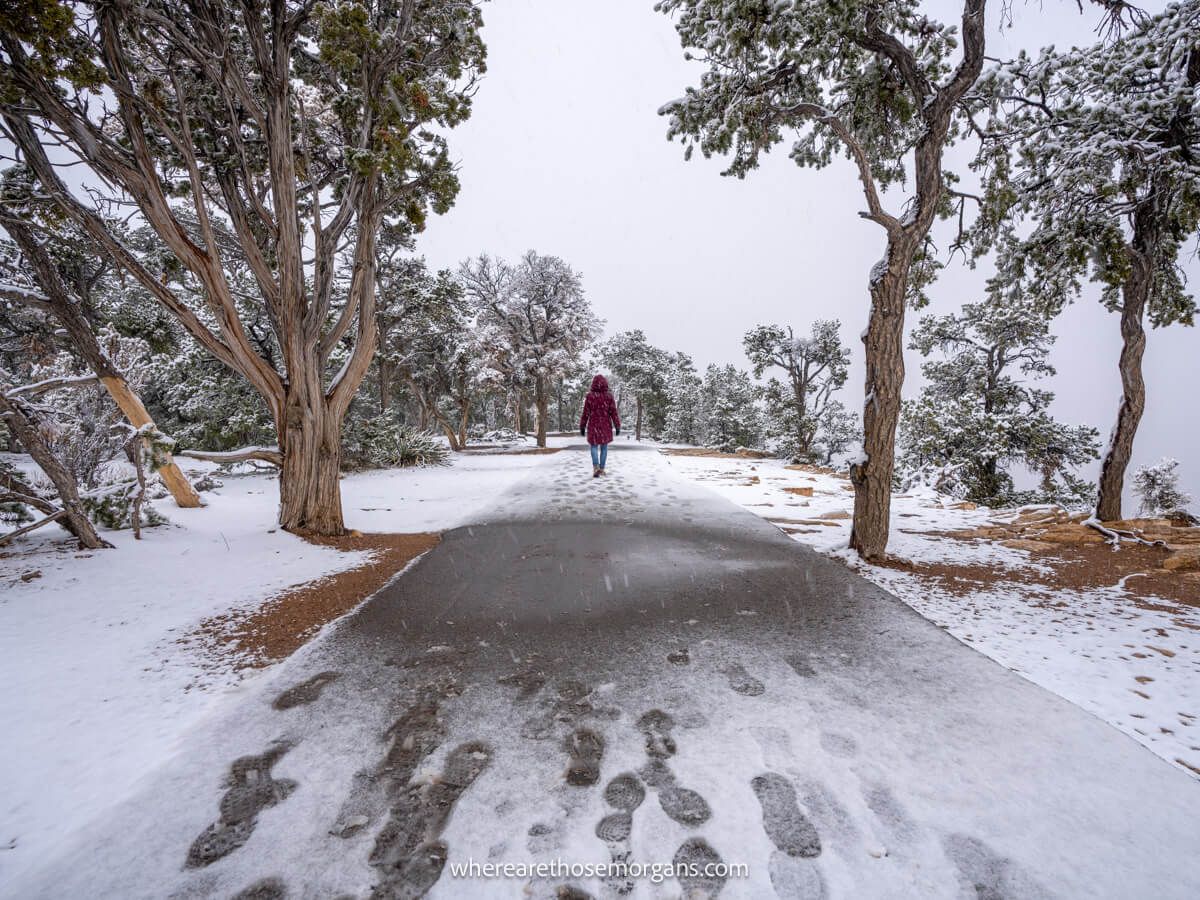The winter months of December, January and February are all excellent times to visit Grand Canyon South Rim to benefit from fewer crowds, cooler hiking temperatures and cheaper hotel rooms. We also liked being able to drive our own car to the popular viewpoints along Hermit Road. And who knows, you might even get a snow day like we did!
In this guide we walk you through the 10 most important things to know about visiting Grand Canyon South Rim in winter, based on our experiences.
Our Experience

We first visited South Rim back in October 2019 as part of a three month American southwest road trip. It was busy at all the viewpoints and hotels were either booked up or expensive. Temperatures on the rim were perfect for exploring, but it was in the low 80’s at Phantom Ranch which would have made hiking down into the canyon dangerous.
Then we revisited in December 2021 to day hike South Kaibab to Bright Angel (the legendary Rim-to-River Trail). And we got so lucky. Our first day was clear and cool, so we were able to complete the hike. But the very next morning we woke up to blizzard-like conditions. The rim was covered in snow and the canyon was filled with thick clouds. So, that’s how fast it can change! Read more about us.
1. Crowds
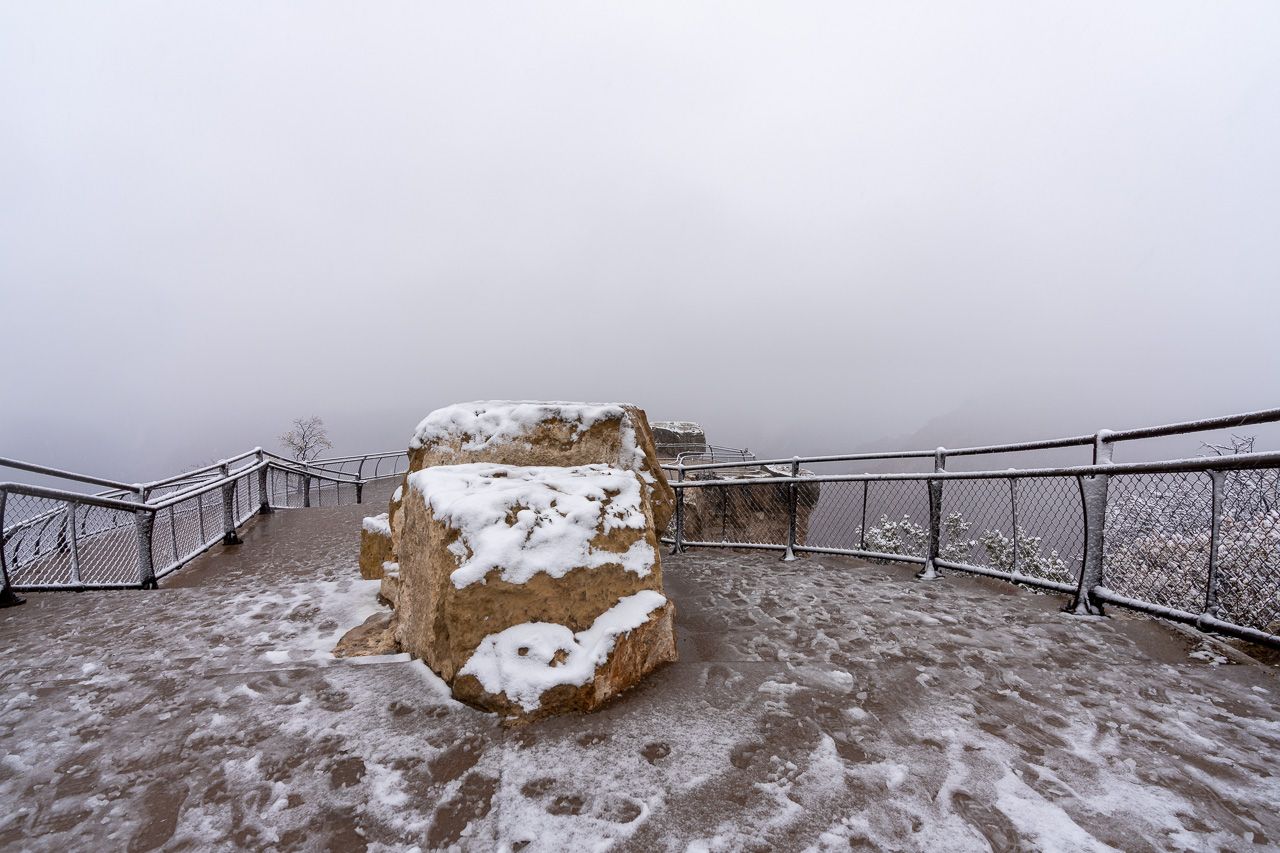
The Grand Canyon is among the world’s most famous national parks, it’s one of the major highlights on millions of American southwest road trips each year, and it’s a true bucket list destination for international visitors.
But what you might not know is that South Rim’s visiting areas are actually quite condensed, which is why overcrowding can be an issue in peak months. There’s not much room to spread out.
According to NPS statistics, the Grand Canyon received the following amount of visitors between 2019-2023:
- 2019 – 5,974,411
- 2020 – 2,911,887
- 2021 – 4,550,921
- 2022 – 4,732,101
- 2023 – 4,733,705
Tourist numbers might not have recovered to pre-covid visits, but 4.7 million is still a lot of people and around 90% of those visitors only go to South Rim. That’s a lot of tourists all vying for the same hotels, viewpoints and hikes.
But South Rim follows the typical trend with tourist numbers: It’s busiest in the summer when schools are out (despite being the hottest and most expensive time to visit), spring and summer are shoulder seasons, and winter is the low season. It’s also busier on weekends and holidays, which includes the Christmas holidays in winter.
So December does have a busier period for around 2 weeks during Christmas and New Years. But even that period is nowhere near as busy as it gets in July or August. We highly recommend visiting Grand Canyon in January or February if avoiding crowds is your top priority, they’re the two quietest months of the year.
Here’s what we can tell you from experience: South Rim was so much quieter in December compared to when we visited in October. In winter, we enjoyed the freedom of the park for sunrises, sunsets, viewpoints and hikes. Plus, we could drive our car along Hermit Road and we had complete flexibility when it came to hotels.
How Will Fewer Visitors Benefit You?
- The viewpoints will be quieter and easier to access.
- Desert View Road won’t be backed up with cars.
- Fewer visitors means Hermit Road is opened to cars.
- Grand Canyon village shuttle buses won’t have long lines.
- Hiking is more pleasant with fewer people on the trails.
- Photography is easy and relaxing thanks to more space.
- Hotels are more affordable due to low demand.
- It’s easier to book rooms last minute for added flexibility.
READ: What’s the best time to visit Grand Canyon?
2. Weather
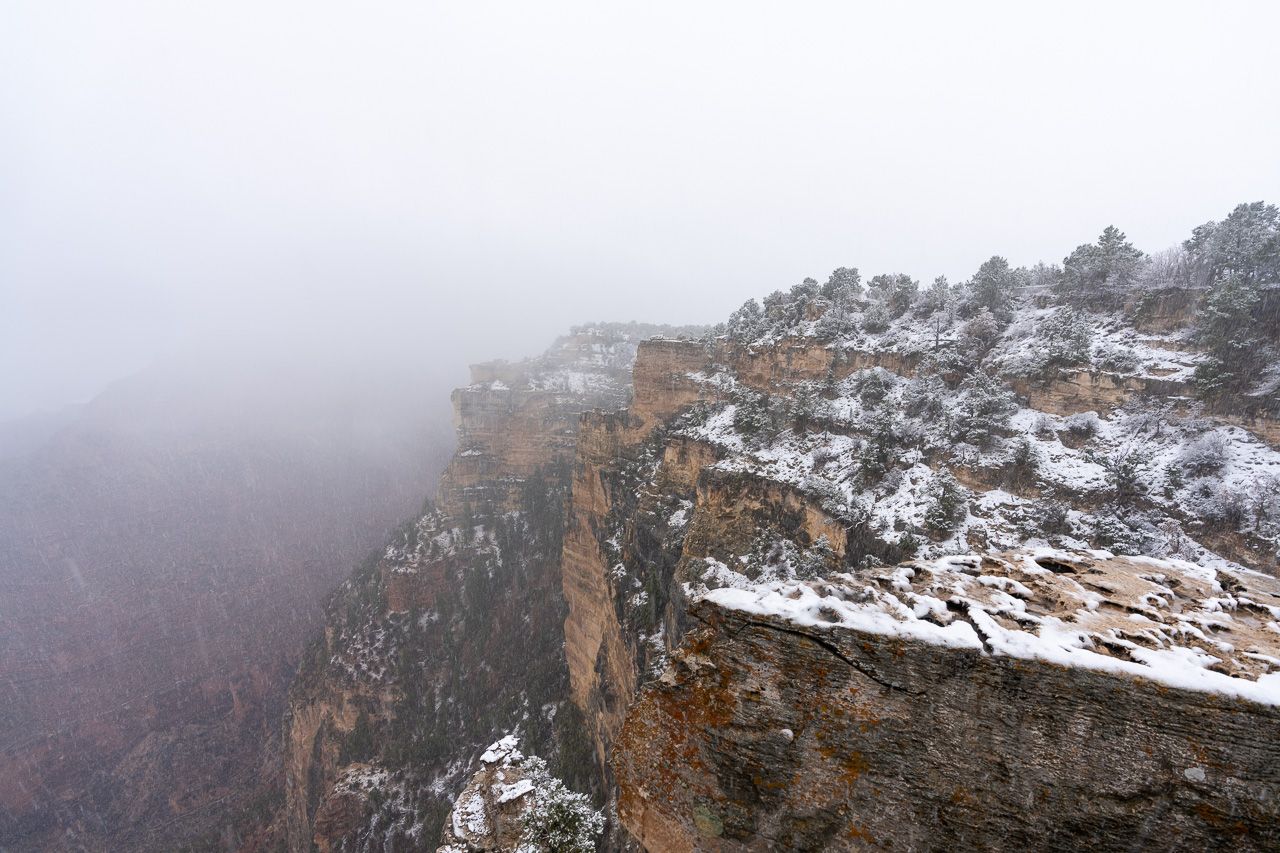
Okay, let’s get the major downsides out of the way. The biggest drawbacks to visiting Grand Canyon South Rim in winter are icy cold temperatures and risk of weather so bad that you end up losing a day or two from your itinerary.
Be under no illusions, it will be very cold in the mornings, evenings and overnight. But you might also be pleasantly surprised by cool or even warm days, which can be perfect for hiking. Here are the average high and low temperatures in winter:
December:
- High – 43F (6C)
- Low – 17F (-8C)
January:
- High – 43F (6C)
- Low – 17F (-8C)
February:
- High – 47F (8C)
- Low – 20F (-7C)
Source: Weather Spark
It’s important to know these temperatures refer only to the top of South Rim at Grand Canyon Village. If you hike down into the canyon, the temperatures are warmer (but they’re not dangerous like they are in summer).
Now, if you’re instantly put off by those averages, remember that the beginning of December and the end of February are noticeably less cold when compared to January. And you’d still benefit from all the perks of a winter visit.
It’s also important to remember that Grand Canyon’s winter weather is unpredictable and extremely changeable. As we mentioned earlier, we had a lovely day followed immediately by a cold snow day when we visited in December. The difference was like night and day. Mark wore shorts and a light top layer the first day, then pants and a heavy fur coat the next. We essentially lost our entire second day.
The take home is that you could have glorious weather or the whole place could be completely shrouded in fog. That’s the risk you run with a winter trip. But as far as we are concerned, it’s a risk worth taking. This unpredictable and cold weather is what allows you to see the unique landscape in relative solitude.
How Much Snow Does Grand Canyon Get During The Winter?
Both South Rim and North Rim receive significant snowfall each winter. Here are the averages:
- South Rim – 58 inches
- North Rim – 145 inches
- Phantom Ranch – 1 inch
As you can see, North Rim takes the brunt of the snowfall even though it’s only 18 miles away as the crow flies. Why? Because it’s 1,000 feet higher in elevation above sea level (South Rim is 7,000 ft and North Rim is 8,000 feet). Only 1 inch of snow makes it to Phantom Ranch at the bottom of the canyon each year before it melts.
If you want to time your visit with snow, January has the highest average snowfall and the most days with snowfall. Just remember to use extreme caution around the rim edges if it snows or drops below freezing following rainfall. Hiking into the canyon and walking around viewpoints with significant drop offs can be treacherous when icy.
Important Grand Canyon winter weather resources:
Need help planning your trip to Grand Canyon?
Our popular Grand Canyon travel guidebook helps you with planning every aspect of your visit to South Rim, including the best viewpoints and hikes, where to eat and stay, itinerary ideas and map!
View Guidebook
3. Roads

Some of the most popular US national parks close entirely during the winter season, but Grand Canyon South Rim remains open year round. All roads into and around the rim are open, but they are subject to occasional temporary closures when the weather takes a turn for the worse.
The truth is, road closures are rare so you’d be unfortunate to arrive on a day when they’re forced to close off a route. We never had any issues at all with roads, even on the day it snowed the routes were all completely clear.
Our advice is to keep a very close eye on live road conditions at Grand Canyon South Rim before and during your winter visit. Any major road closures will appear at the top of the page as you can see in the screenshot we took for the photo above.
Just so you know, the main entrance to South Rim is from the south on AZ-64 from Williams, Flagstaff, Sedona, Las Vegas and Phoenix. East entrance is the only other way in or out of South Rim, and it connects to Page, Moab and Zion.
All of the airports near Grand Canyon will also remain open throughout the season winter, outside of any unusual circumstances. So it’s unlikely you’ll have any problems with flights or rental cars. What about inside the park?
Hermit Road
Hermit Road connects the main village area to all viewpoints on the west side of South Rim. From March through November the only way to access these viewpoints is to take a shuttle bus, walk or cycle. But in winter from December through February you can drive your own car along Hermit Road.
Why does that matter? Well, some of Grand Canyon’s top sunrise and sunset photo spots are located along Hermit Road, including the most popular sunset location called Hopi Point. Driving yourself means you can be totally flexible, without waiting in line for a shuttle.
Desert View Drive
Desert View Drive connects the main village area to all viewpoints on the east side of South Rim. Sure, you can access the road by car year round, but the beauty of visiting during the winter season is that you won’t have any issues getting parked at any of the viewpoints because there’s fewer people around.
4. Lodging
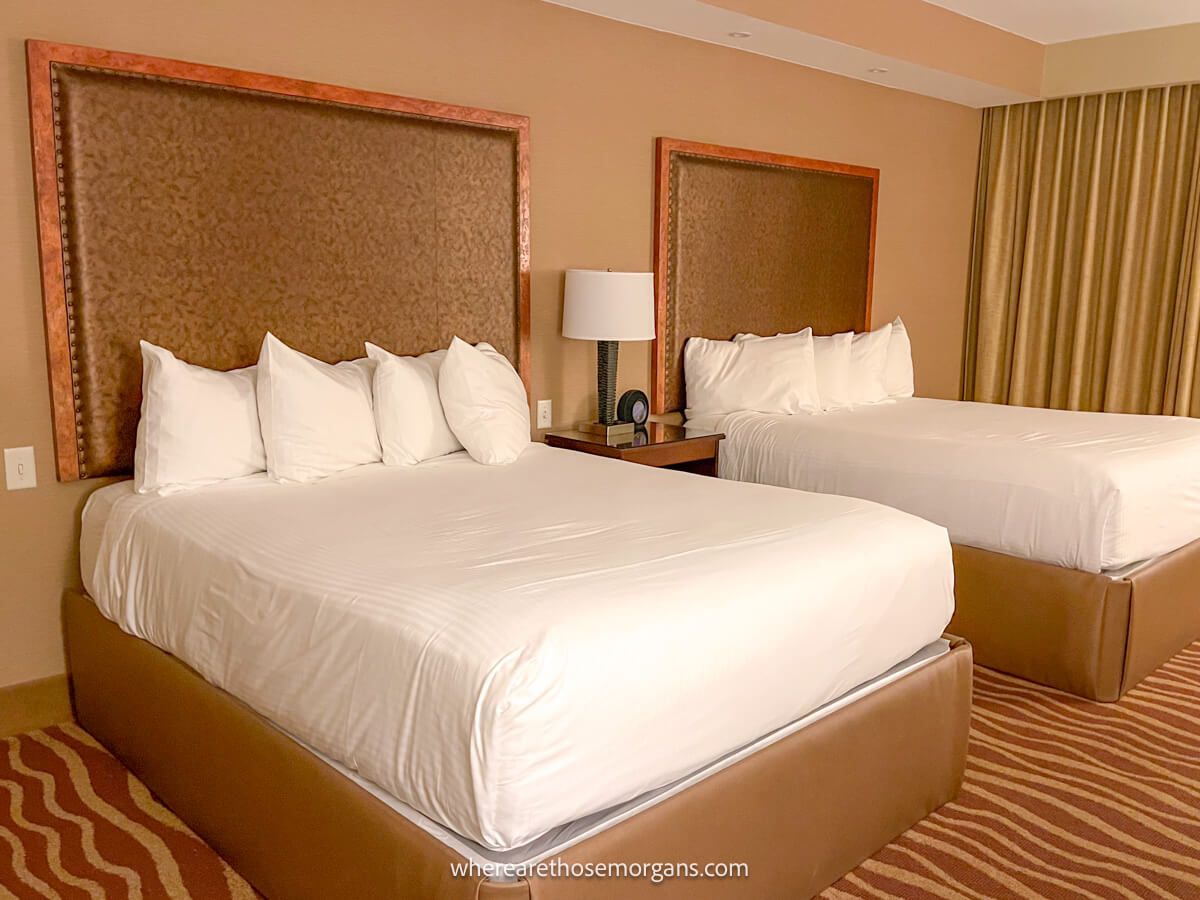
Have you visited any of the most popular US national parks in peak season? Booking hotels at parks like Yellowstone and Yosemite can be a real problem because demand outweighs supply. Well, it’s the same at Grand Canyon South Rim in every season other than winter.
In peak months, park run lodging on the rim fills up early and prices are heavily inflated. Hotels in nearby towns like Tusayan and Valle also increase prices in the summer. But hotel occupancy rates are very low in winter (with the exception of the Christmas holidays). And lower demand means lower prices for us.
We tried and failed to find any value with a last minute booking when we visited in October. But we had the pick of the crop when we visited in December and we stayed in a great hotel at a very reasonable rate.
Park Run Accommodation
Okay, there are 7 official Grand Canyon lodging options on the South Rim:
- El Tovar
- Bright Angel Lodge & Cabins
- Kachina Lodge
- Thunderbird Lodge
- Maswik Lodge
- Yavapai Lodge
- Phantom Ranch
We spent a night at Bright Angel Lodge a few years ago and it was a fun experience. It’s perched right on the edge of the rim above Bright Angel Trail, and we got a cheap and cheerful room for a good price.
If you want to stay on the rim, start by looking at prices directly through Grand Canyon Lodges. Take note of the prices, then see you can beat them by going to hotels.com and typing the name of each lodge in the search box along with your dates.
Where To Stay Near South Rim
Tusayan is the closest resort town to South Rim with a few solid hotel options. We stayed in the Best Western in Tusayan during our trip to South Rim in December and it was a great stay. Valle (also known as Grand Canyon Junction) is next closest. It has a cheap motel and a few luxury glamping options.
Williams is the closest big town with lots of hotels and restaurants. We stayed in the Best Western in Williams and had another great experience. Finally, Flagstaff is the closest city with a far greater selection of hotels. It’s perfect for day tripping into the Grand Canyon and Sedona on the same trip.
We’ve written a helpful guide explaining the places to stay near Grand Canyon South Rim if you want to learn more. Otherwise, we’ll list some of the top rated hotels in each area near South Rim for you to check out below.
Tusayan:
Williams:
Flagstaff:
Tip: Head over to our sister site Best Hotels Anywhere for a closer look at the top hotels near South Rim and the top Williams AZ hotels.
5. Hiking
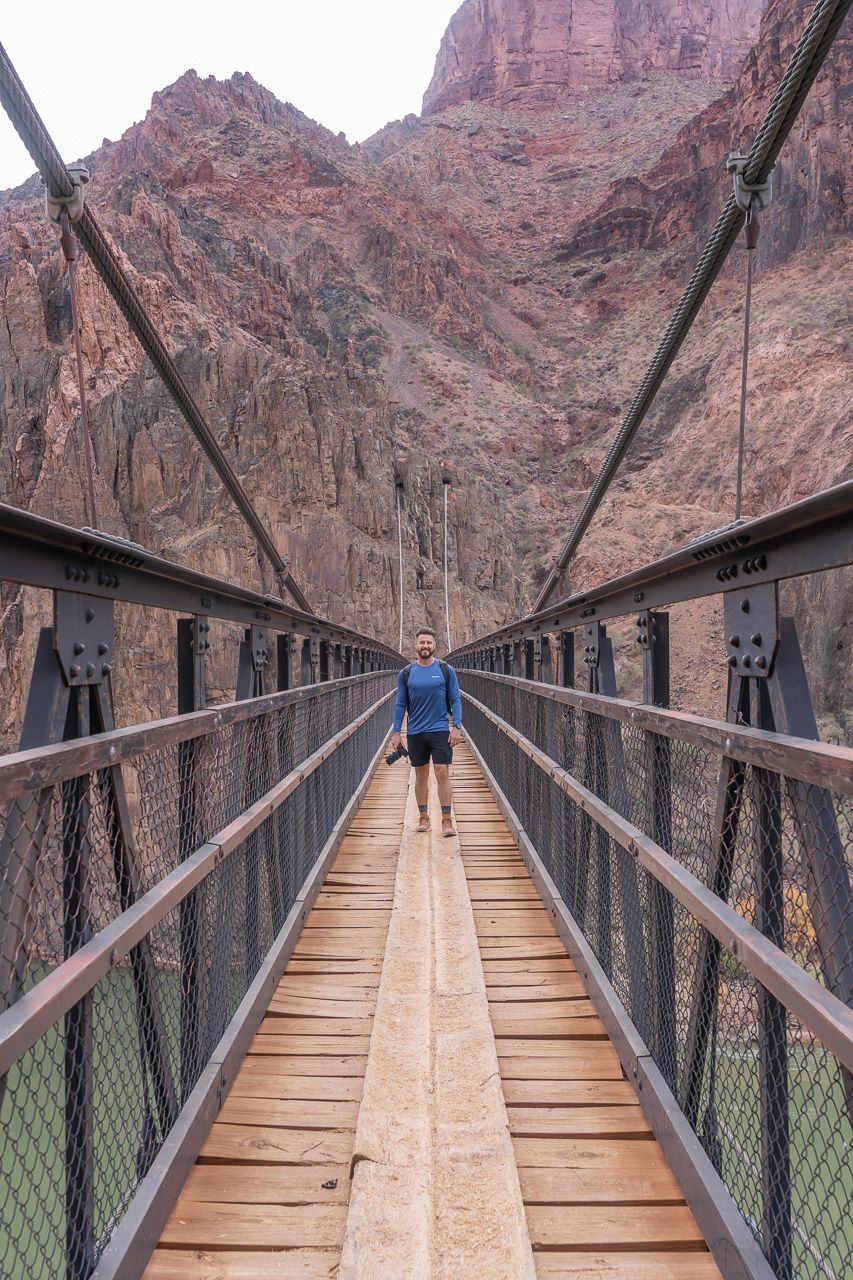
Being a big sweaty mess is all we can remember from hiking at the Grand Canyon in October! It was hot and high up in elevation, so we felt like we were being cooked. It’s amazing how many rescues have to be made because hikers don’t realize that it’s like an oven inside the canyon. Sadly, there are fatalities each year.
It’s the reason we revisited in December. We wanted to hike Rim to River in a day, so we played it safe by choosing a cold winter month. It was freezing when we set off for South Kaibab Trailhead on the shuttle, but the sunrise was stunning and it soon warmed. Conditions improved through the morning and ended up being perfect for hiking back up in the afternoon.
If you only want to hike the Rim Trail or a small portion down either Bright Angel Trail or South Kaibab Trail, just wait until 10:00am so you avoid the coldest part of the morning. And remember, you’ll also benefit from quieter trails because there are fewer daily visitors.
Tips For Safe Hiking In Winter
- You must get an early start if you take on Rim to River.
- Watch for ice on trails at all times, especially in the shadows.
- Don’t hike at all if the weather is too dangerous.
- Check weather reports for the day ahead.
- Take layers to account for temperature changes.
- Carry plenty of water and food no matter how far you plan to hike.
- Wear shoes with good tread on trails into the canyon.
6. Photography
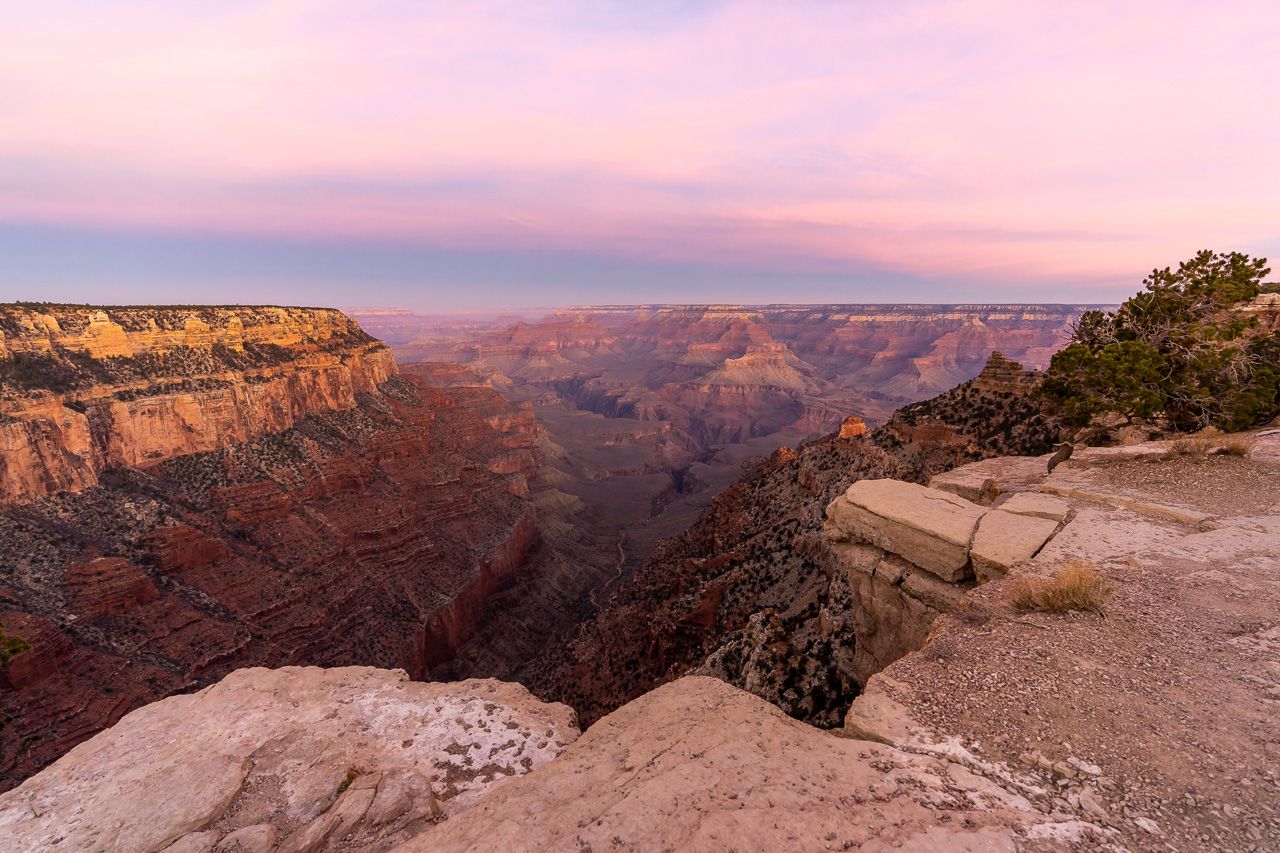
Words like breathtaking and jaw-dropping get thrown around far too often for our liking, but the Grand Canyon was one of few places that genuinely made us say wow the first time we saw it. And we traveled the world non-stop for 6 years.
It’s easily one of the most photogenic landscapes on the planet, so it’s the perfect place to take home a bunch of amazing images to show your family and friends. And in winter, you have the unique opportunity to (maybe!) see it covered in snow.
But you don’t want snow like we had, which was basically snow clouds completely filling our view of the canyon. You want snow on the ground without the clouds. And even if it doesn’t snow at all, you’ll still be able to capture the almost unbelievable scale of the canyon below.
Another huge benefit of a winter visit is that you’ll be at South Rim during the shortest days of the year. That means you don’t have to wake up too early to catch a sunrise or stay out too late to watch a sunset. And remember, you can also drive your car up Hermit Road, so you can easily make it to the most popular Grand Canyon viewpoints at dawn and dusk.
Our Winter Photography Tips
- Wear plenty of heavy layers including fingerless gloves or mittens for sunrises and sunsets.
- The rim east of Mather Point is quieter and there are small secluded outcrops you can access.
- Hopi Point gets busy at sunset so arrive early to grab a parking spot, even in winter.
- Temperatures change very quickly once the sun comes up or goes away so prepare accordingly.
- Don’t get too close to the rim edges if there’s a chance of ice.
7. Packing
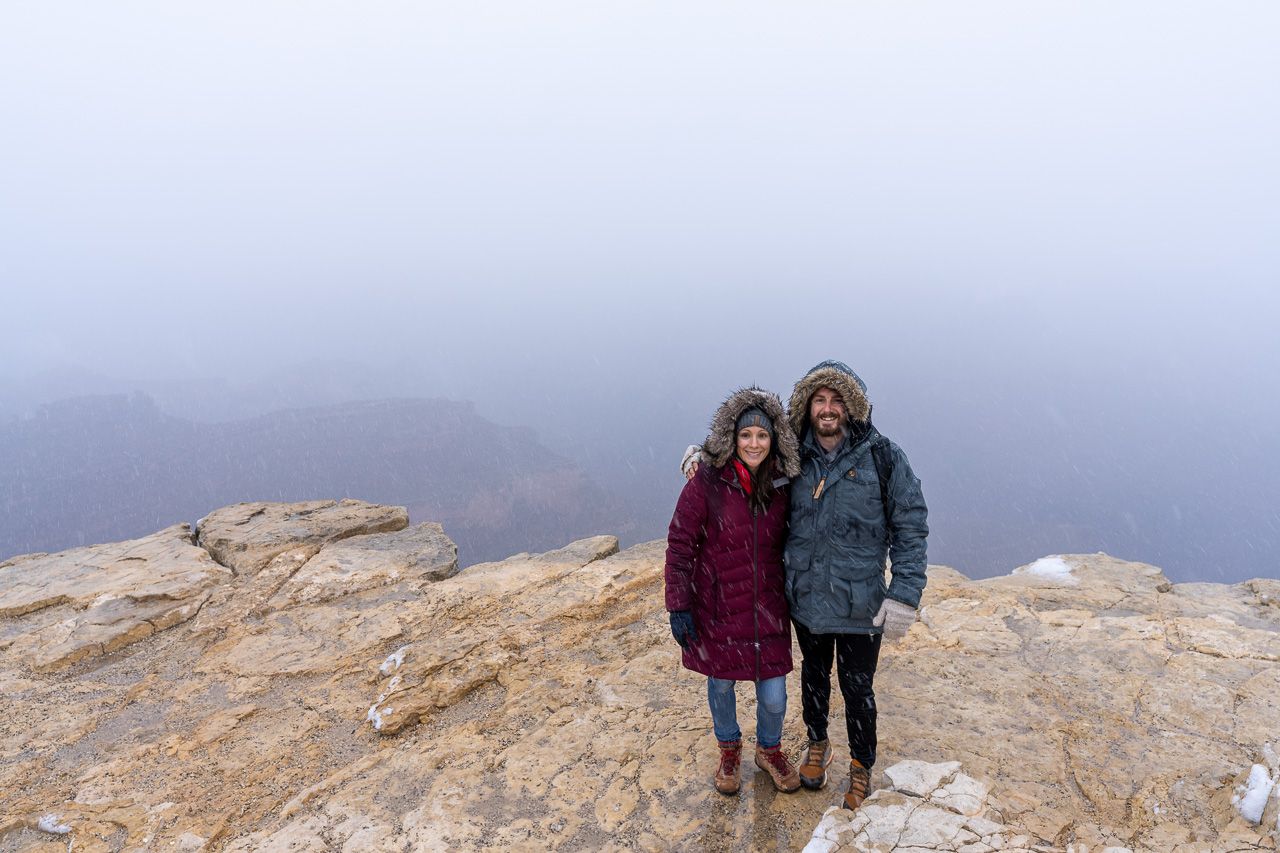
Packing for the Grand Canyon in winter can be challenging. You could pack all your heavy gear and it ends up being mild, and on the other hand you could take a risk by packing light but it ends up snowing the entire time. We hate overpacking, but this is the time to do it. As the old saying goes, it’s better to be safe than sorry.
As you can see in the photo of us above, we’re wearing heavy coats, gloves and hiking boots in the snow. And yet, the day before we were hiking all day in shorts and light upper layers. So our advice is to pack lots of layers including base layers, light middle layers, thicker outer layers, rain and windproof coats, thick heavy coats and gloves.
You’re going to need the warmer gear if you plan to watch sunrise or sunset because it will be cold at dawn and dusk. If you want to hike you should take completely different outfits to account for mild weather or cold weather, including trail runners and hiking boots so you have options.
8. Restaurants
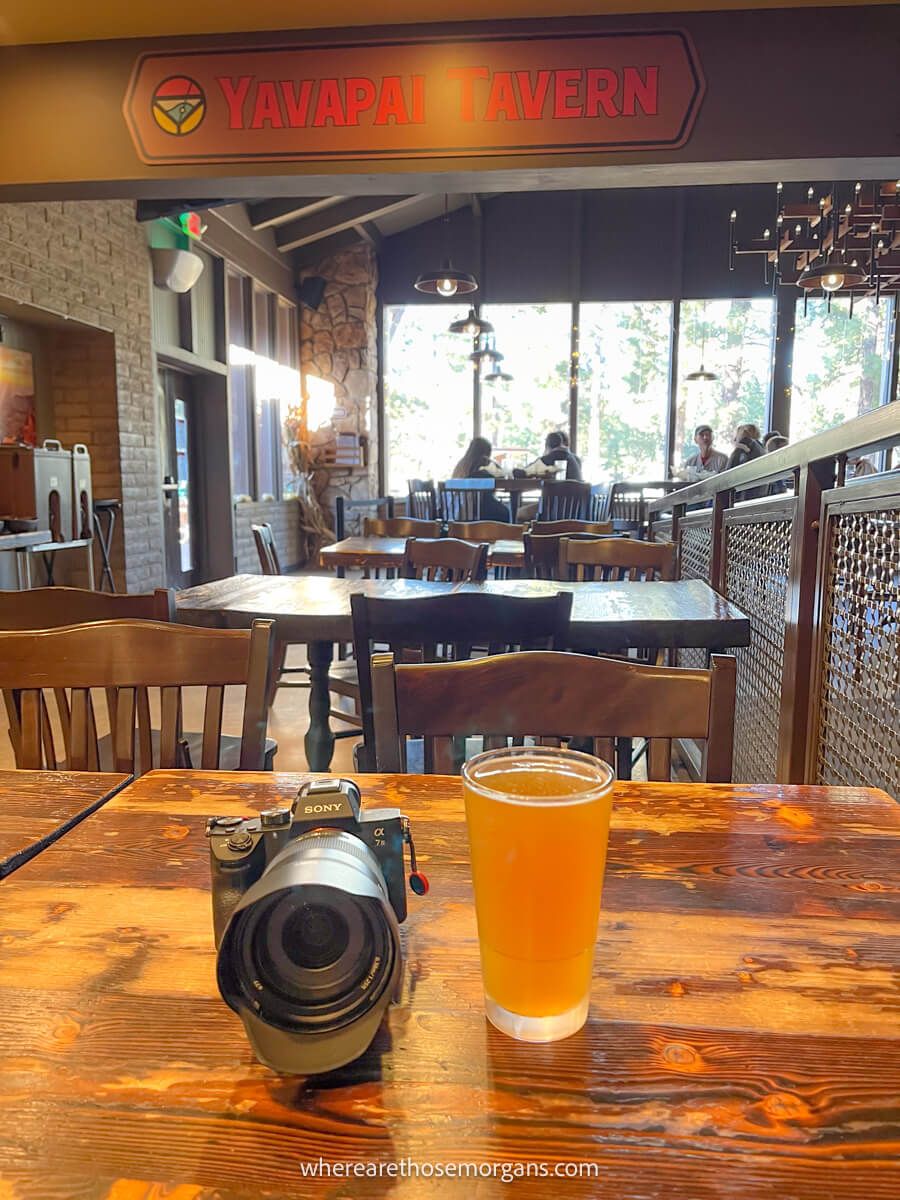
You’ll be happy to hear that eating out at all places in and around Grand Canyon South Rim is exactly the same in the winter as any other time of year. Everything is open and food is available at the lodges, restaurants and cafes.
Now, this is just our opinion, but we have to say during both our visits to South Rim we’ve been disappointed by the selection of food options on offer. Not just inside the park, but also at the resort towns nearby. Williams and Flagstaff are great for food, but closer to South Rim it’s not great.
Here are your options:
- Yavapai Lodge – Tavern with a bar for a quick pizza and a beer.
- Market and Deli – Good if you have a kitchen or campsite but it’s expensive.
- Desert View Tower – Canteen style cafe for a light lunch (actually pretty good).
- Tusayan – A dozen options including typical fast food but none are rated very highly.
- Williams or Flagstaff – Excellent food selections but are an hour away from South Rim.
With that said, the important thing is that all available food options remain open year round. So you wouldn’t have to deal with limited food options if you visited in the winter months. And to be fair, food won’t matter so much if you’re only there for a night or two.
9. North Rim
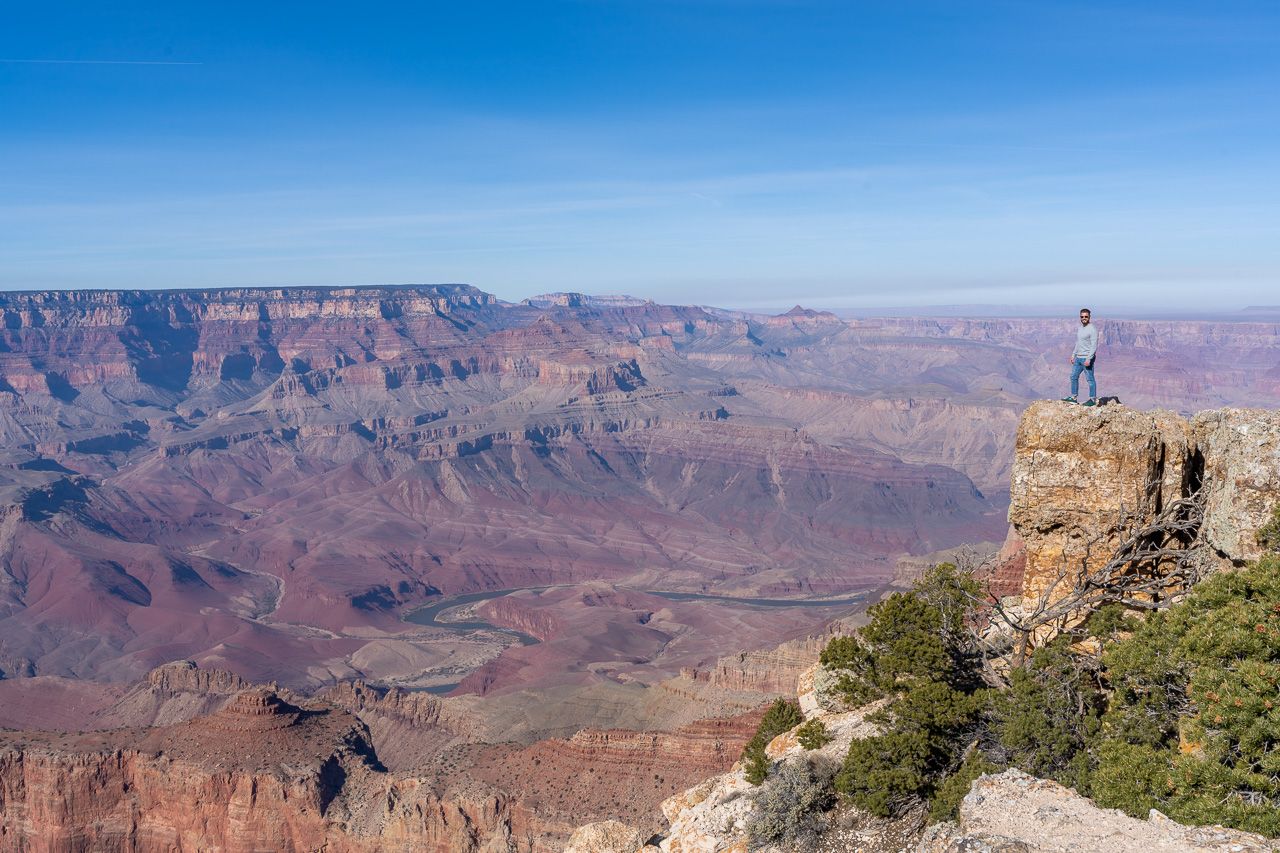
Here’s another minor downside to visiting Grand Canyon National Park in the winter: North Rim closes for the season. We say minor because only 10% of visitors to Grand Canyon ever step foot on North Rim, but in winter you won’t even have the option because it gets hit with 145 inches of snow.
It’s fully open mid-May to mid-October each year. Then from mid-October it’s only open for day use (you can’t stay over) before it shuts down entirely for the winter season at the beginning of December. As a result, you’ll have no choice but to miss out on views and hikes from the north side of the national park.
So far we haven’t made it to North Rim because it’s either been closed or we didn’t have time. However, we think it would be an incredible experience so we fully intend to visit the 8,000 ft high rim at some point soon. If you typically prioritize staying clear of the crowds, you should head over to North Rim. Just don’t do it in winter!
READ: The places you can’t miss in Arizona
10. Christmas Activities
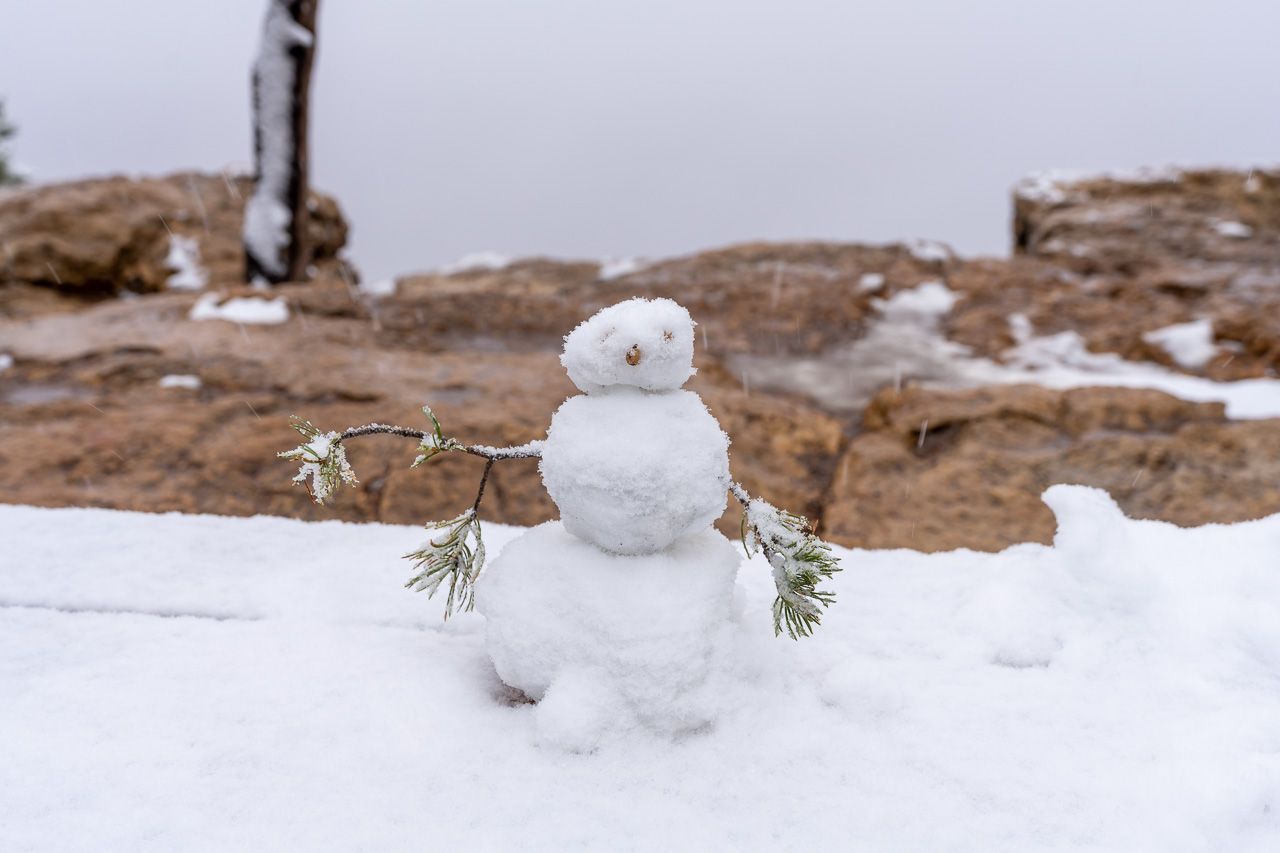
Are you visiting the Grand Canyon at Christmas with your family? You absolutely shouldn’t miss the chance to ride the evening Polar Express from Williams to the North Pole (also known as the Grand Canyon South Rim depot).
The popular child-friendly train ride leaves at 5:30pm and 7:30pm from Williams with a total trip time of approximately 90 minutes. Tickets are fairly pricey beginning at $57 per adult and $38 per child (and that’s if you book early) but it’s family fun at its festive finest. We have a little one on the way so we’d definitely do the train ride next time.
There’s not much else going on in terms of Christmas festivities or activities other than the train, but remember you could always just build little South Rim snowmen like we did!
The Morgan Conclusion
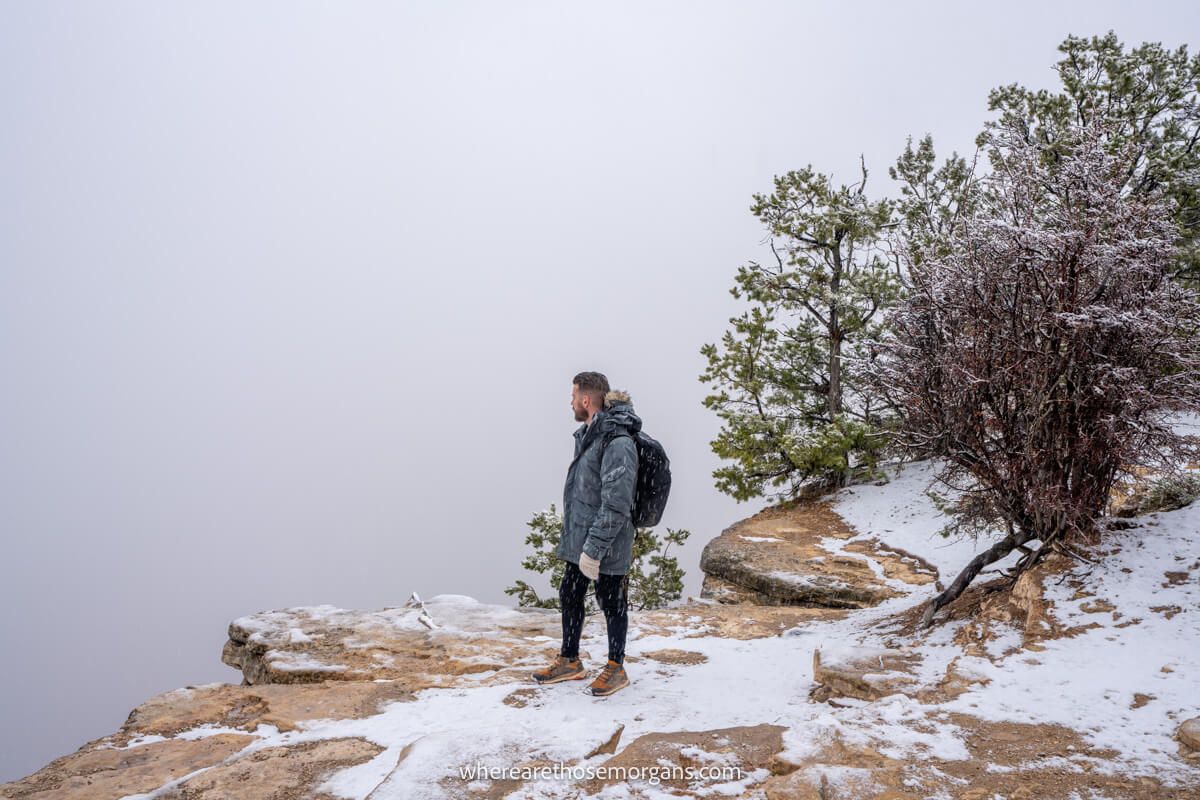
What we like: For us, visiting in winter was all about safely day hiking Rim to River. We also loved how quiet it was at sunrises, sunsets and almost the entire time we hiked inside the canyon. Being able to use our own car was also amazing because we didn’t have to wait for shuttles or lose flexibility.
What we don’t like: The obvious one is cold temperatures at dawn and dusk. We’re not huge fans of being cold, but in reality it only impacted on our overall enjoyment a tiny amount because we just wrapped up in heavy coats. The other huge issue is potential for getting caught up in bad weather during your trip. We effectively lost our second day.
Is it worth visiting Grand Canyon in winter? Yes! Grand Canyon South Rim is quiet, affordable and completely open in the winter. It’s also safer to hike into the canyon, the trails are crowd-free and the popular photo spots are almost empty. If you don’t mind cold mornings and evenings, we think the winter months are among the best times of year to visit South Rim.
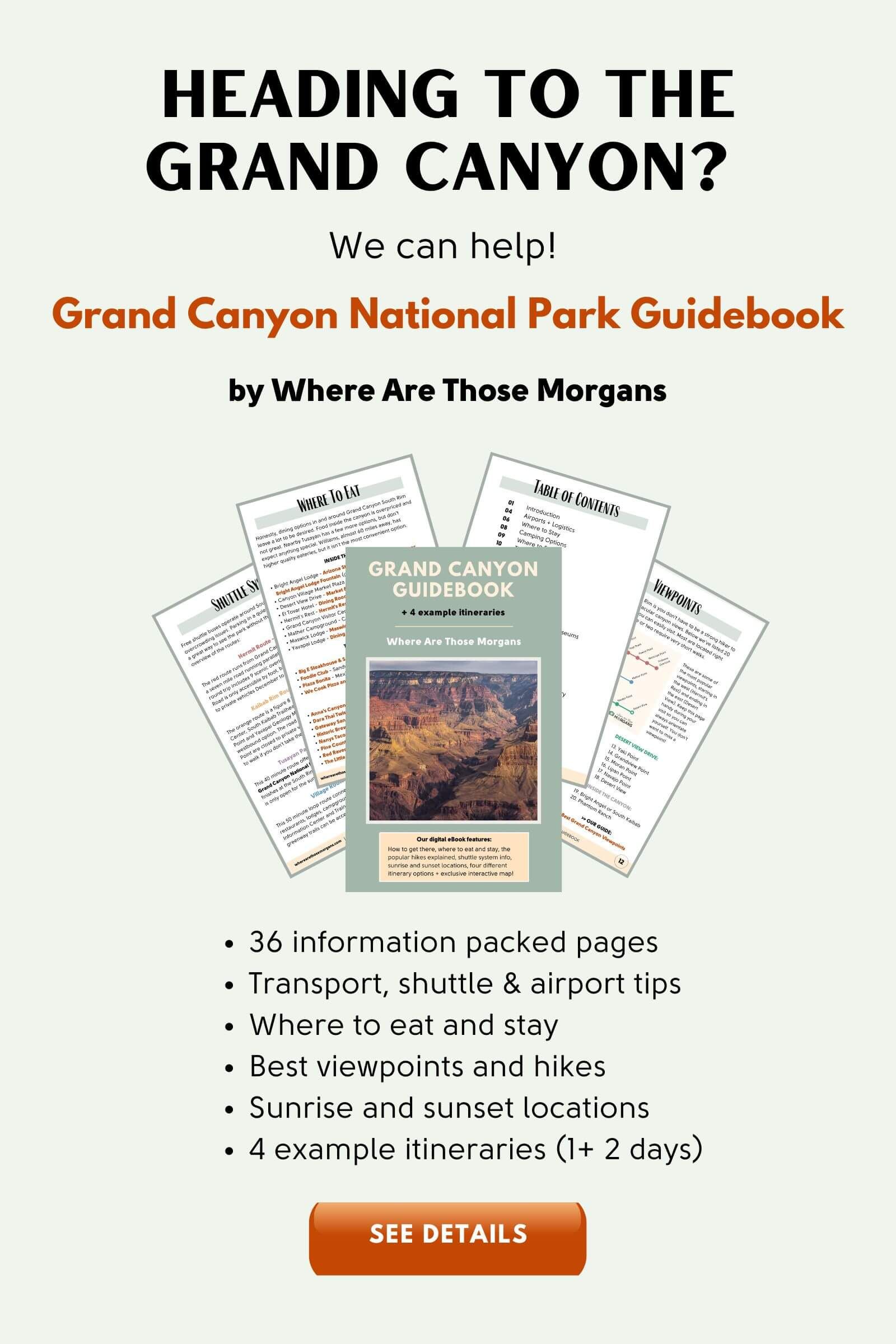
More From Grand Canyon
- Amazing Grand Canyon South Rim viewpoints
- Best day hikes at Grand Canyon South Rim
- Best season to visit the Grand Canyon
- Closest airports to Grand Canyon National Park
- How to hike Bright Angel Trail
- How to hike South Kaibab Trail
- Grand Canyon sunrise and sunset photo spots
- South Kaibab to Bright Angel hiking guide
- Guide to visiting Grand Canyon for the first time
- Where to stay at Grand Canyon South Rim
Want more Arizona content? Head over to our Arizona Travel Guides to explore the best of Grand Canyon, Sedona and beyond.
We hope our guide visiting Grand Canyon South Rim in the winter helps with planning your visit to Arizona!
Please let us know if you have any questions in the comments below.
Happy Travels,
Mark and Kristen
Find this guide helpful? Pin it for your visit!

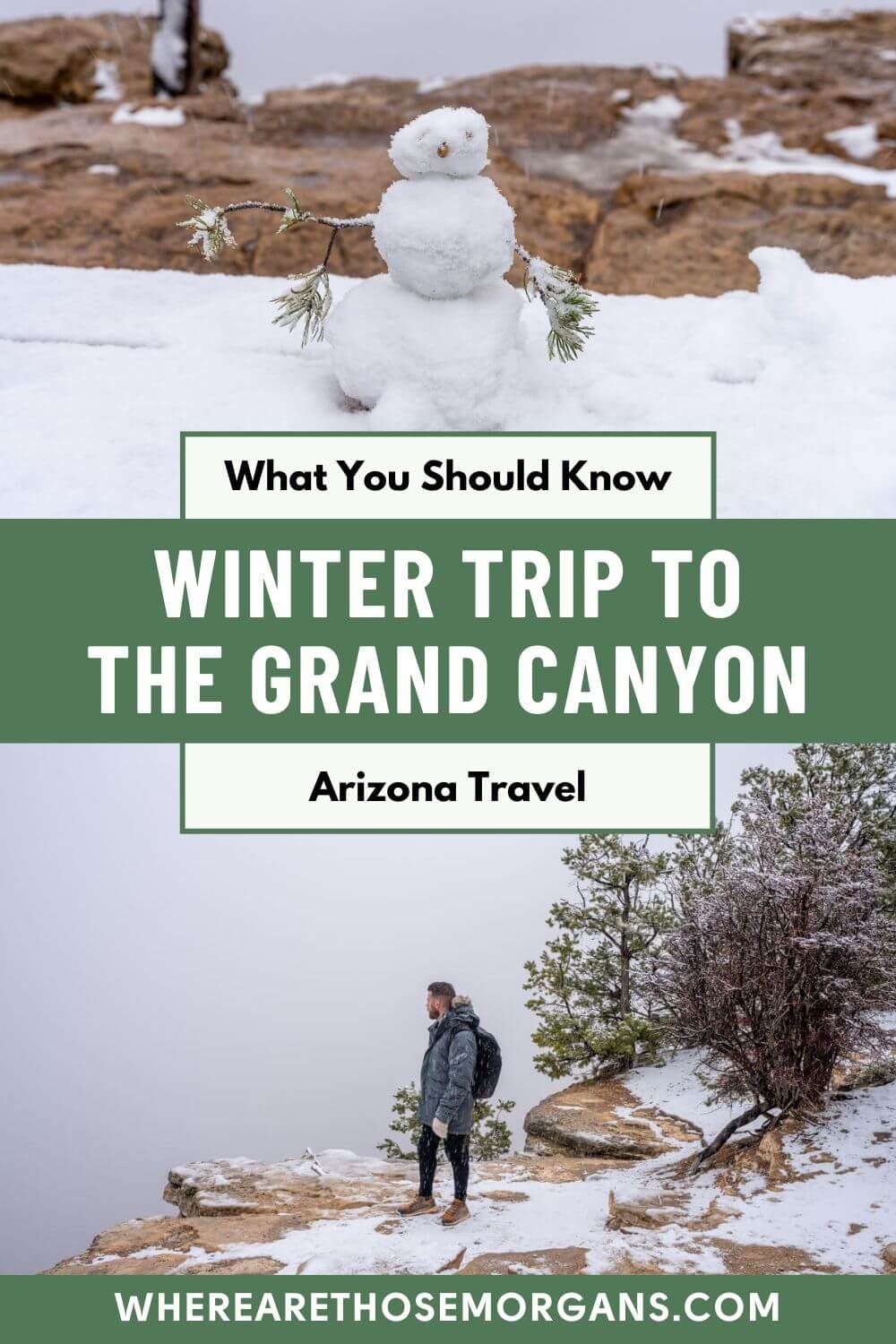
Note: This article contains affiliate links. When you make a purchase using one of these affiliate links, we may earn a small commission at no extra cost to you.
All Rights Reserved © Where Are Those Morgans, LLC. Republishing this article and/or any of its contents (text, photography, maps, graphics, etc.) in whole or in part is strictly prohibited.
Mark and Kristen Morgan are travel, hiking and photography experts. Over the last 6 years traveling full time, they have explored more than 40 countries and 30 US states.
Where Are Those Morgans has been featured in USA Today, Gestalten, Get Your Guide, CityPASS and Condé Nast Traveler along with various other publications. Read more about us.

